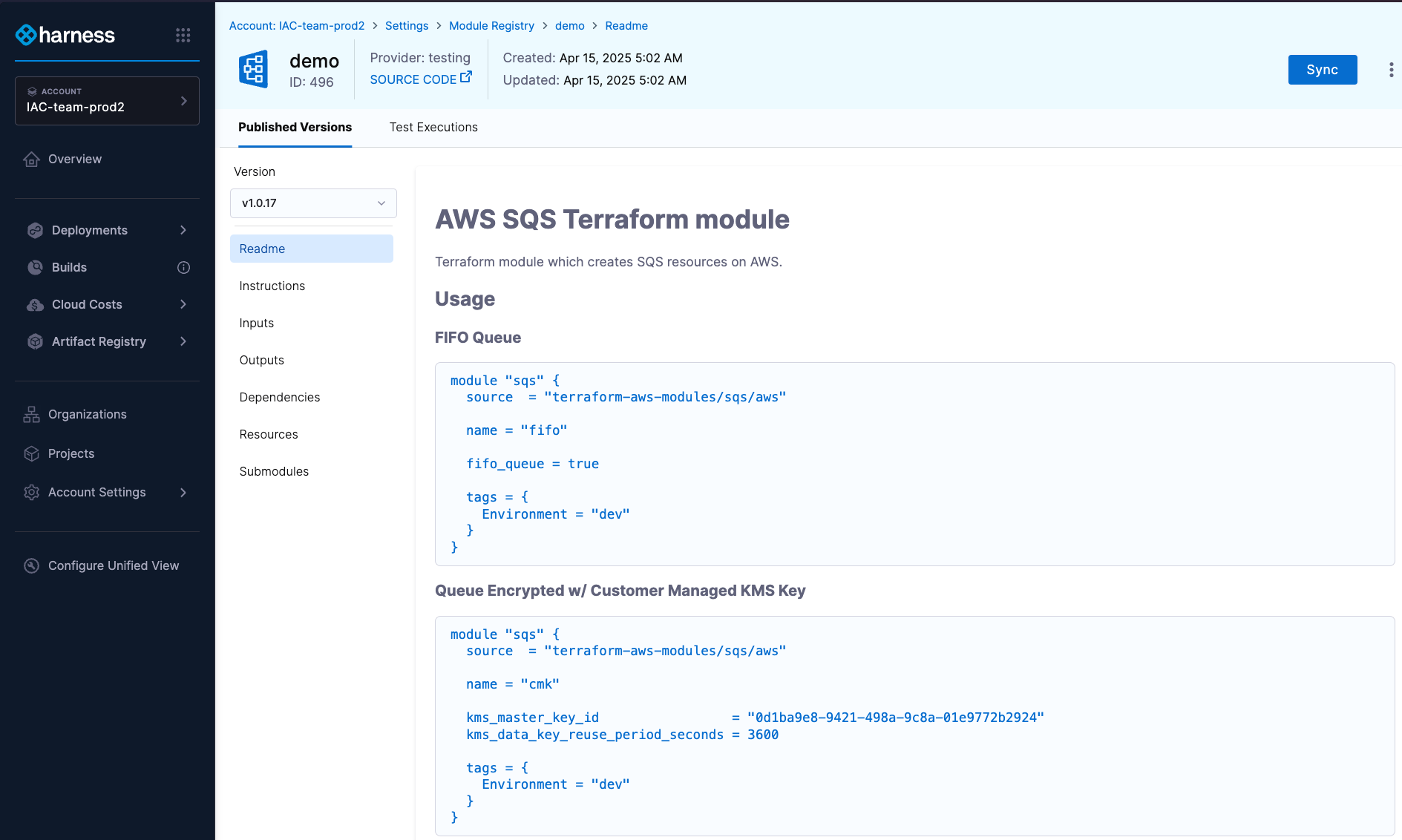
This article explores how the software engineering principle of DRY (Don't Repeat Yourself) is revolutionizing infrastructure management through module registries in tools like OpenTofu and Terraform. It highlights how these registries, exemplified by the Harness IaCM Module Registry, enhance consistency, reduce errors, and streamline infrastructure setups. The piece underscores the transformative impact of module registries on DevOps practices, from boosting collaboration and security to enabling seamless scalability across projects.
As software professionals—whether you're a developer, DevOps engineer, or managing infrastructure, the DRY (Don't Repeat Yourself) principle is a foundational concept you're likely familiar with. In the world of code, this principle encourages us to minimize repetition by reusing components, libraries, and frameworks wherever possible. It's all about making your work more efficient, consistent, and maintainable.
The same principle holds true when working with infrastructure as code (IaC). With tools like OpenTofu and Terraform, we can avoid repetition by using reusable modules — pre-packaged pieces of infrastructure code that can be imported and deployed across various projects. These modules act like software libraries but are tailored for infrastructure management, allowing us to streamline the process of provisioning and managing infrastructure components such as networks, databases, and servers.
Streamlining Infrastructure Management with a Module Registry
If you've ever worked with code dependencies or libraries, you'll find the concept of a module registry quite familiar. A module registry is a centralized location where reusable components—modules—are stored, managed, and shared. These modules represent pre-built pieces of infrastructure code that can be easily imported into your projects to set up common infrastructure components, such as virtual machines, databases, and networks.
For example, instead of writing new code each time you need to spin up a database server, you can import a pre-built module from the registry. This approach helps developers avoid "reinventing the wheel," speeding up deployment and making infrastructure code easier to maintain.

Let's explore how module registries are transforming the landscape of infrastructure management and why they're becoming an essential tool in the modern DevOps toolkit.
The Evolution of Infrastructure Management
Traditionally, setting up and managing infrastructure involved a lot of manual work. DevOps engineers would often find themselves copying and pasting code snippets across different environments, leading to inconsistencies and a higher likelihood of errors. This approach was not only time-consuming but also prone to configuration drift – a situation where environments that should be identical slowly become different over time due to manual changes and inconsistent updates.
Let's look at an example of how infrastructure might have been set up in the past:
In this example, every detail of the VPC, subnet, and security group configuration is defined manually. Now imagine having to replicate this across multiple projects or environments. The potential for errors and inconsistencies becomes apparent, not to mention the time investment required to set up and maintain such configurations.
Enter the Module Registry
A module registry is a centralized repository where reusable infrastructure components – modules – are stored, managed, and shared. These modules are pre-packaged pieces of infrastructure code that can be easily imported and deployed across various projects. Think of them as the infrastructure equivalent of software libraries.
By leveraging a module registry, DevOps teams can:
1. Enhance Consistency: Use standardized, pre-approved modules across projects and environments.
2. Improve Efficiency: Reduce the time spent on repetitive tasks by reusing existing modules.
3. Minimize Errors: Decrease the likelihood of misconfigurations by using tested and verified modules.
4. Facilitate Collaboration: Share best practices and expertise across teams through well-documented modules.
5. Enable Version Control: Manage different versions of infrastructure components, allowing for controlled updates and rollbacks.
Let's revisit our previous example, this time using a module from a registry:
In this updated version, we're using a pre-built network module that encapsulates the complexity of setting up a VPC, subnets, and associated resources. Not only is this code more concise, but it also ensures that best practices are followed consistently across all instances where this module is used.
The Harness IaCM Module Registry: A Closer Look
While the concept of module registries isn't new, platforms like the Harness IaCM Module Registry are taking it to the next level by integrating seamlessly with existing DevOps workflows and providing additional features that enhance security, governance, and ease of use.
Key features of the Harness IaCM Module Registry include:
1. Centralized Storage: All modules are stored in one secure location, making it easy to share and update them across projects.
2. Version Management: Modules are versioned, allowing teams to specify exact versions in their projects, ensuring stability and predictability.
3. Security and Access Control: Granular controls over who can access modules and enforce policies for updates.
4. Integration with CI/CD Pipelines: Seamless integration with existing CI/CD workflows, automating deployment and enhancing consistency across environments.
5. Automated Syncing: The ability to automatically sync modules with their source repositories, ensuring that the registry always contains the latest versions.
For detailed instructions on how to implement and use the Harness IaCM Module Registry in your workflow, refer to the official Harness developer documentation.
The Impact of Module Registries on DevOps Practices
The adoption of module registries is having a profound impact on DevOps practices:
1. Accelerated Development: By eliminating the need to reinvent the wheel for every project, teams can focus on building and deploying applications faster.
2. Improved Collaboration: Shared modules foster knowledge sharing and collaboration between teams, breaking down silos between development and operations.
3. Enhanced Security: Centralized management of infrastructure modules allows for better control over security practices and easier implementation of security patches across all projects.
4. Scalability: As organizations grow, module registries provide a scalable way to manage increasingly complex infrastructure needs without a proportional increase in management overhead.
5. Cost Optimization: Reusable modules can be optimized for cost-effectiveness, ensuring that best practices for resource utilization are consistently applied across all projects.
Challenges and Considerations
While the benefits of module registries are clear, their implementation does come with some challenges:
1. Learning Curve: Teams need to adapt to thinking in terms of modular infrastructure, which may require some initial training and adjustment.
2. Module Maintenance: As with any shared resource, modules need to be maintained, updated, and deprecated when necessary. This requires ongoing effort and clear ownership.
3. Balancing Flexibility and Standardization: There's a delicate balance between providing standardized modules and allowing for the flexibility needed in diverse projects.
4. Version Management: As modules evolve, managing different versions and ensuring compatibility can become complex.
The Future of Module Registries
As we look to the future, module registries are poised to play an increasingly central role in infrastructure management. We can expect to see:
1. AI-Assisted Module Creation: Machine learning algorithms helping to generate and optimize infrastructure modules based on best practices and usage patterns.
2. Cross-Platform Compatibility: Enhanced interoperability between different cloud providers and on-premises infrastructure through standardized module interfaces.
3. Automated Compliance Checking: Built-in tools for automatically verifying that modules meet industry standards and compliance requirements.
4. Dynamic Module Composition: The ability to dynamically compose complex infrastructure setups from smaller, more granular modules based on application requirements.
Conclusion
The adoption of module registries represents a significant leap forward in the world of infrastructure management. By embracing the DRY principle and leveraging tools like the Harness IaCM Module Registry, DevOps teams can dramatically improve their efficiency, consistency, and ability to scale.
As we continue to push the boundaries of what's possible in software development and deployment, module registries will undoubtedly play a crucial role in shaping the future of DevOps practices. Whether you're managing a small startup's infrastructure or orchestrating complex systems for a large enterprise, embracing module registries is a step towards more robust, maintainable, and efficient infrastructure management.
The journey towards fully modular infrastructure may seem daunting, but the benefits far outweigh the initial investment. As you embark on this path, remember that each module you create or reuse is a step towards a more streamlined, secure, and scalable infrastructure.
For those currently using Terraform and considering a switch, OpenTofu provides a smooth migration path. You can find detailed instructions on how to migrate from Terraform to OpenTofu in the official OpenTofu documentation.
The future of DevOps is modular – are you ready to embrace it?
